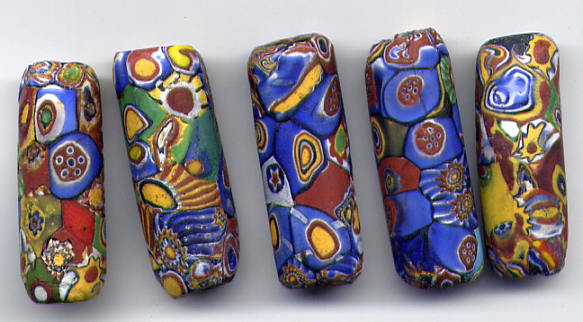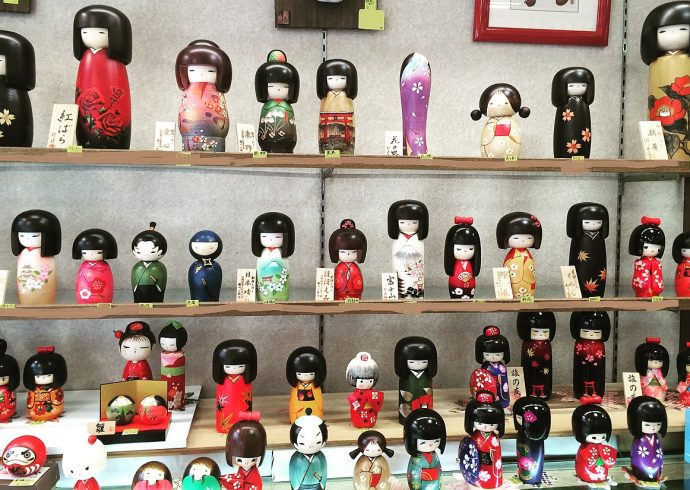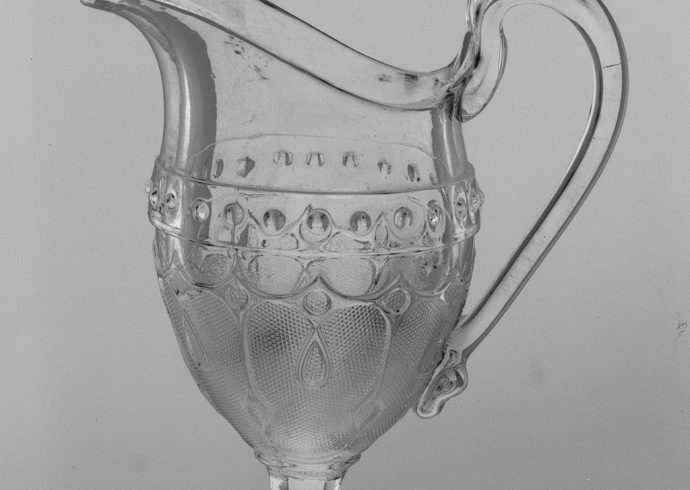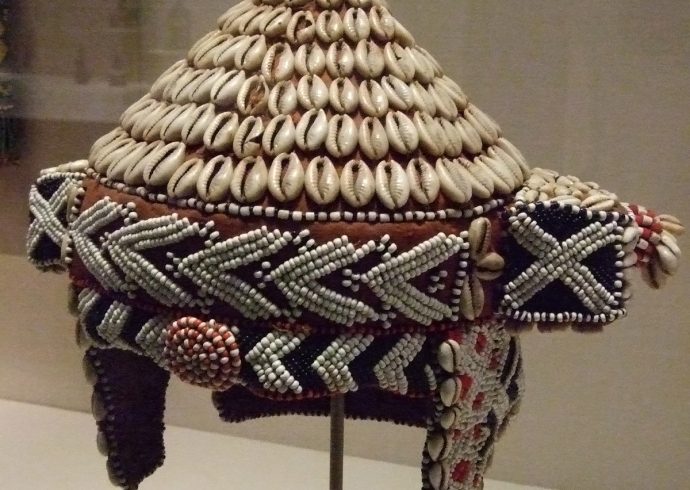
The History of Millefiori or Mosaic Glass
The art form known today as millefiori (Italian for “thousand flowers”) has a long history that began with ancient Egypt several thousand years ago and is still be manufactured today, in everything from glass to pottery and wax. It has been used in making tableware, floor tiles, paperweights, and jewelry. The mention of millefiori usually brings to mind fancy paperweights made by such companies as Baccarat and Clichy, or Italian mosaic jewelry made from tiny cut millefiori canes.
The first pieces of mosaic glass were discovered in Egypt around 1400 B.C.E. What is unusual about mosaic glass is that it has been produced at different intervals at different times in history. No one culture can lay claim to being the only one to producing millefiori glass. The Egyptians produced it, followed by the Persians, Roman Empire, Islamic world, then the Italians, who finally gave the mosaic glass its present name of millefiori. During the second century B.C.E. The Romans would create the circular glass shapes using two or three different colors and use them in glassware, then not again until the fifteenth century in Venice. What is significant that during each period millefiori was made, is that it utilized the same methods: making glass canes with a design inside each cane, then cutting the canes and arranging them into a dish or bowl shape, and fusing them together with another piece of glass. For this reason, millefiori is sometimes referred to as murrine, which involves small pieces of cut glass melded together to create a larger piece of glass.
The Persians can be credited to being the first to creating millefiori beads and using them in jewelry. These beads were used as far back as the Bronze Age but became popular in use during the Parthian dynasty, from the fourth to first century B.C.E. The beads were found in tombs at Gilan, a province in northern Iran near the Caspian Sea. The color of the beads were white, yellow, and black and were referred to as eye beads for their simple design. Other beads found at the Dailaman region also in northern Iran date from the first to the third century C.E. at what is called the Noruz-mahale tomb. Other mosaic beads in the shape of tangerines in pale blue were also found at the same site. More mosaic beads were found at the nearby Hassani-mahale tomb in Dailaman.

Beginning with the Hellenistic period, mosaic glass was made by fusing slices of canes that contained cross sections patterns in them. During the first century B.C.E. the Romans started making millefiori glass bowls and floor tiles. A number of these pieces have survived and are in museums today, which shows how the distinct millefiori pattern evolved over the centuries.
During the Islamic period of the Middle East, the first mosaic glass was discovered at Samarra, Iraq, the ‘Abbasid capital between 836 and 892 C.E. These glass pieces were flat, thick, and used as tile floors in the throne room and harem of the building where they were found. The building was the Jawsaq al-Khaqani built by Caliph al-Mu’tasim. The mosaic glass that was found there, however, does not designate if Samarra was the first or last place when it was made during the Islamic empire. Mosaic glass made during this period was not widespread in production and only a few pieces have survived intact. This was the one period during the first centuries of Islam in the Middle East when mosaic glass was produced was under the ‘Abbasids, in the ninth century C.E.
Islamic mosaic glass bore the pattern of a bull’s eye with a round circle in the middle, with another ring of a different color, followed be several more rings of alternating colors to create a final round cane that would then be sliced and fused together to make everyday glassware. Sometimes dots or radial stripes would be added to one of the circles to make a more elaborate design in the cane. It is unknown what the Arabs called the present millefiori technique in their own language but the procedure over the centuries has not changed. A basic bullseye design was made of glass then fused together to make a glass bowl.
The Italians duplicated and imitated the Islamic form of millefiori design in glass that was previously forgotten from centuries past. The crude forms used in Islamic glassware was not as popular in the western part of the Middle East as it once was in previous Sassanian Persia and did not quite live up to the technical creation of millefiori mosaic canes. Millefiori glass was revived after the fall of the Roman Empire starting in the Middle Ages. Prior to that time, millefiori was simply referred to as mosaic glass, since the canes made could be cut and set in a pattern with another color glass set in between them in order to seal them together.
From the time that millefiori canes were manufactured in Venice in vases and plates, the art form eventually found its way to France and England in the eighteenth and nineteenth centuries, primarily in the form of paperweights. Baccarat, Clichy, Saint Louis, and other companies in France created beautiful works of art using canes with elaborate designs of flowers, stars, and pieces resembling candy in their paperweights. During the nineteenth century, the art of millefiori traveled to the United States, bringing European glass makers to the New World to market their skills and produce glassware that attracts antique glass collectors everywhere.
The style of millefiori canes is not confined to glass and pottery, however. The designs can be easily made in wax, and millefiori candles in all kinds of shapes were popular during the 1990’s. Candles in the shape of round balls, teapots, frogs, and cylinders were manufactured and sold inexpensively to the public who liked the look of millefiori but in a different material besides glass.
Some examples of early mosaic glass:
First to third century, Gilan. Mosaic beads of spiral patterns and small circles. The colors used in these beads are red, yellow, and blue.
First to third century, Gilan. Beads with a white four armed cross and a red center against a green background. The green portion is encircled in white with blue bordering it.
Fifth to seventh century, Gilan. A small round glass pendant with a multicolored background of dots and a white rabbit in the foreground. The colors used were: red, blue, green, and gold.
A ninth century bowl with glass mosaic pieces of red and yellow surrounded by emerald green. Found in the western part of the Middle East, possibly of Syrian origin.
Ninth century small bowl, with light and dark green, yellow and red mosaic pieces. Mesopotamia.
A ninth century knife handle, with opaque red and orange, light and dark green, and yellow canes. Mesopotamia.
Ninth century tile fragment found at Samarra has canes of yellow and green, yellow and red, white and red, turquoise, black with white and red, and yellow and green.
A ninth century bowl from Iraq has white and red, green with yellow and red, red and green, red and yellow, and white and red canes fused to brown and turquoise glass.
Ninth century bowl from Iraq has white with red and blue canes fused with yellow glass.
A ninth to tenth century bowl from Iraq has yellow, white, and black small canes. The bowl has a narrow foot.
Late ninth century molar flask has orange, blue, white, red, and green canes, western part of the Middle East. The foot of the flask resembles a molar tooth. The flask was used for perfumes or scented oils.
Image Credit: EvelynS en.wiki, CC BY-SA 3.0, via Wikimedia Commons.


